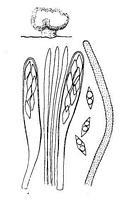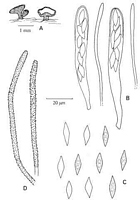|
 Perrotia apiculata Perrotia apiculata
SynonymsDasyscyphus apiculatus
BiostatusPresent in region - Indigenous. Endemic
Images (click to enlarge)
Caption: FIG. 4. Dasyscyphus apiculatus. Habit sketch x 15, details x 660. | 
Caption: Figure 124. Perrotia apiculata, holotype. A. Apothecia. B. Asci and paraphyses. C.
Ascospores. D. Hairs. |
Article: Spooner, B.M. (1987). Helotiales of Australasia: Geoglossaceae, Orbiliaceae, Sclerotiniaceae, Hyaloscyphaceae. Bibliotheca Mycologica 116: 711 p.
Description: APOTHECIA erumpent, short-stipitate, solitary or clustered, often compound with two or more
discs arising from a common stipe. DISC 1.0-1.3 mm diam., plano-concave, pale orange or
cream, outline often undulating or lobed, margin incurved when dry. RECEPTACLE shallow
cupulate or discoid, clothed with white hairs and with a pulverulent appearance, at least when dry.
STIPE cylindric, up to 0.5 mm high, orange-brown, darker than the receptacle and lacking hairs
except towards the apex. HAIRS hyaline, cylindric, obtuse, straight or flexuous, septate, thin-walled, granulate, 3-4 µm diam., often slightly expanded towards the apex, longest, 90-120 µm
long, at the margin, mostly 30-60 µm long on the receptacle and stipe. ASCI 75-85(-90) x 9-12
µm, 8-spored, cylindric-clavate, the apex somewhat narrowed but rounded, thin-walled, the pore
not blue in Melzer's reagent even after pre-treatment in 5% KOH. ASCOSPORES 12-18 x 3.5-5.0, mean 4.6(SD 1.3) x mean 4.3(SD 0.4) µm, hyaline, fusoid or often narrowly rhomboidal, the
ends acute and frequently drawn out into an apiculus-like point, non-septate, 1-or 2-guttulate,
irregularly biseriate. PARAPHYSES hyaline, simple, remotely septate, often tapered but not
acutely pointed at the apex, equal to or slightly exceeding the asci, (1.5-)2.0-2.5 µm diam.
SUBHYMENIUM not clearly differentiated. MEDULLARY EXCIPULUM a hyaline textura
intricata composed of closely interwoven thin-walled, septate hyphae 1.5-2.5 µm diam., becoming
more parallel in the upper receptacle, and not differentiated at the margin. ECTAL EXCIPULUM
up to 40 µm thick at the base of the receptacle, narrower on the stipe and towards the margin,
composed in the stipe of irregularly arranged, narrow hyphae immersed in a gel, the innermost
hyphae in a zone up to 20 µm thick with pale brown walls. On the receptacle, composed of
subparallel agglutinated septate hyphae 4.0-5.5 µm diam., lying at a rather high angle to the
surface below, curving round parallel to the surface at the margin and there forming a textura
prismatica with cells mostly 10-15 x 3-4 µm.
Habitat: On bark of Nothofagus fusca (Hook. f.) Oersted.
Distribution: Known
only from the type locality.
Notes: This species is still, unfortunately, known only from the type collection which, as noted by Dennis
(1961), is somewhat scanty and not well-preserved. Further material would be desirable for study
to clarify its generic position, but the excipular structure is evidently not that of a Lachnum nor
are the asci characteristic of that genus. The asci have a broad, thin-walled, undifferentiated apex
which, as also noted by Dennis, is typical of Perrotia., and the excipular structure is also
consistent with this genus. Although the ascospore shape is quite unlike that of the type species,
it is acceptable for Perrotia in the broader concept of the genus adopted here.
Article: Dennis, R.W.G. (1961). Some inoperculate Discomycetes from New Zealand. Kew Bulletin 15(2): 293-320.
Notes: The rather round-topped asci lacking a pore-plug stained blue by iodine suggest a Perrotia but
the paraphyses, though slender, seem to be pointed at the tip and the spores are not like those
of other Perrotias. The material is unfortunately scanty and in poor condition and the generic
position may be reconsidered when better collections are available. Spores of a rather similar
trapezoidal shape, 8-12 µ long, were described for Lachnum trapeziforme Vel., on Carpinus
leaves in Czechoslovakia.
|